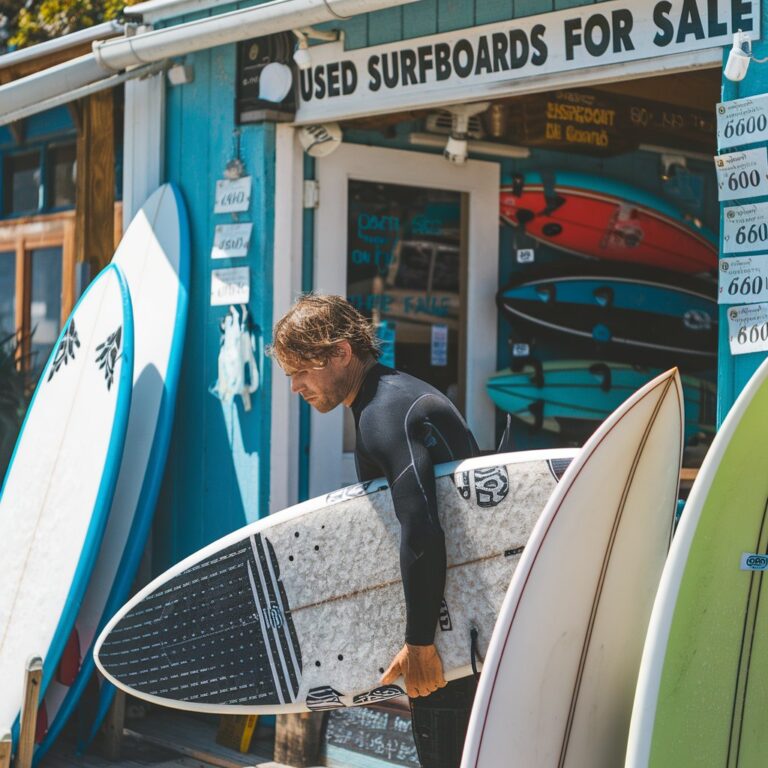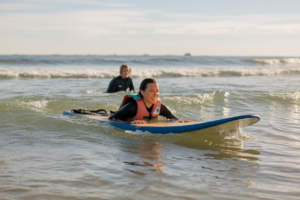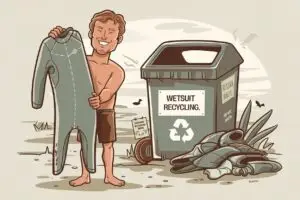Purchasing a used surfboard can be a fantastic way to get into the sport without breaking the bank. Whether you’re a seasoned surfer looking to expand your quiver or a beginner eager to catch your first wave, finding the right board at a great price is crucial.
But how do you navigate the marketplace and ensure you’re getting a good deal? With our comprehensive guide, you’ll learn 28 money-saving tips that will help you find a high-quality used surfboard without compromising on performance or condition.
From understanding different types of surfboards to negotiating prices and inspecting for hidden damages, we’ve got you covered. Dive in and discover the savvy surfer’s secrets to scoring a great board on a budget!
Why Buy A Used Surfboard?
The allure of buying a used surfboard lies primarily in its cost-effectiveness. New surfboards can be pricey, especially high-performance models. Opting for a pre-owned board can save you a considerable amount of money while still providing a quality surfing experience. Plus, there’s a certain charm in owning a board with a bit of history – it’s already seen some action and has a story to tell.
Key Considerations
When delving into the used surfboard market, several factors must be considered to ensure you make a wise purchase. Here’s a rundown of what to keep in mind:
- Board Type and Size: Different surfboards cater to different styles and skill levels. Longboards, shortboards, fish, funboards – each has its unique attributes. Consider your experience level and the type of waves you’ll be riding.
- Condition: Inspect the board meticulously. Look for dings, cracks, and delamination. While minor repairs are often manageable, extensive damage could affect performance.
- Brand and Model: Do a bit of research to know which ones hold their value and are well-regarded in the surfing community.
- Price: Have a budget in mind and stick to it. Used surfboards vary widely in price depending on age, condition, and brand. Don’t be afraid to negotiate.
- Seller Reputation: Whether you’re buying from a surf shop, an online marketplace, or a fellow surfer, consider the seller’s reputation. Reviews and word-of-mouth can be telling.
Where to Look
Finding a used surfboard can be as simple as checking your local surf shop or as expansive as scouring the internet. Here are some places to consider:
- Surf Shops: Many surf shops sell used boards. They often provide a certain level of assurance regarding the board’s condition and might offer a return policy.
- Online Marketplaces: Websites like Craigslist, eBay, and specialized surf forums can be goldmines for finding used boards. However, exercise caution and ensure you’re dealing with reputable sellers.
- Surfing Communities: Local surfing communities and clubs often have members looking to sell their boards. This can be a great way to get a good deal and meet fellow surfers.
- Social Media: Follow surfboard brands and surf shops that might post about used boards for sale.
Making the Purchase
When you find a potential board, arrange a meeting to inspect it in person if possible. Here’s a checklist to guide your inspection:
- Check for Dings and Repairs: Lightly tap the board and listen for hollow sounds indicating delamination.
- Examine the Fins and Fin Boxes: Ensure they’re not cracked or damaged.
- Look at the Deck and Bottom: The deck should be smooth, and the bottom free from significant pressure dings.
- Feel for Soft Spots: Press gently along the board to check for soft areas, which can indicate water damage or weak spots.
28 Money-Saving Tips for Buying a Used Surfboard
Embarking on the quest to find the perfect used surfboard can be both exciting and overwhelming. This section will guide you through the process, from understanding what to look for to negotiating the best price.
Understanding the Market
- Do Your Research: Familiarize yourself with different types of surfboards and their typical prices.
- Know Your Needs: Identify the type of board that suits your skill level and the waves you plan to ride.
- Set a Budget: Determine how much you’re willing to spend and stick to it.
Where to Buy
- Check Local Surf Shops: These often have a selection of used boards and knowledgeable staff.
- Explore Online Marketplaces: Websites like Craigslist and eBay can offer great deals.
- Join Surfing Forums: Engage with communities where surfers sell their used boards.
- Social Media Platforms: Use Facebook Marketplace and Instagram to find boards for sale.
Inspecting the Board
- Look for Dings and Cracks: Minor dings are usually repairable, but extensive damage might not be worth the hassle.
- Check for Delamination: Press on the board and listen for hollow sounds indicating separation of the layers.
- Examine the Fins: Ensure they are not cracked or loose.
- Inspect the Deck and Bottom: Look for pressure dings and other damage.
- Feel for Soft Spots: These can indicate water damage or weak areas.
Negotiating the Price
- Know the Market Value: Understanding typical prices helps in negotiating a fair deal.
- Be Polite and Respectful: Approach negotiations with courtesy.
- Highlight Any Damage: Use existing damage as leverage to lower the price.
- Offer Cash: Sellers might be more willing to negotiate for a quick, hassle-free sale.
Additional Considerations
- Check the Age of the Board: Older boards might be cheaper but could also have more wear and tear.
- Ask About the Board’s History: Knowing how often it was used can give insight into its condition.
- Consider the Brand: Some brands are known for durability and quality, which can be a better investment.
- Look for Previous Repairs: Ensure repairs were done professionally.
- Verify Authenticity: Be cautious of counterfeit or poorly made replicas.
Making the Purchase
- Meet in Person if Possible: Inspecting the board firsthand is always best.
- Ask for a Test Ride: If feasible, try the board in the water to see how it performs.
- Get a Second Opinion: Bring a knowledgeable friend to the inspection.
- Avoid Rushed Decisions: Take your time to ensure you’re making the right choice.
- Check Return Policies: Some sellers, especially shops, may offer returns or exchanges.
- Document the Transaction: Keep records of your purchase for future reference.
- Celebrate Your Find: Enjoy the satisfaction of scoring a great deal!
Finding the Right Board for Your Skill Level
Selecting the ideal surfboard is akin to finding a dance partner; it should complement your skill level and surfing style.
Beginner Surfers
As a beginner, your primary focus should be on stability and ease of paddling. Here’s what to consider:
- Longboards: These boards are typically 8-10 feet long, providing excellent stability and making it easier to catch waves. They are perfect for learning the basics of balance and wave-riding.
- Foam Boards: Also known as soft tops, these boards are forgiving and safer for beginners. They offer a soft surface, reducing the risk of injury during wipeouts.
For a complete guide on foam boards, read this article: Wave Bandit vs Catch Surf: Foam Surfboard Guide
Intermediate Surfers
Once you’ve mastered the basics and are comfortable catching waves, it’s time to step up your game:
- Funboards: These are a middle ground between longboards and shortboards, usually around 7-8 feet. Funboards offer a balance of stability and maneuverability, making them ideal for intermediates.
- Fish surf board: Known for their wide, short shape, fish boards provide great speed and are excellent for smaller waves. They offer more maneuverability than longboards but still maintain good stability.
Advanced Surfers
For seasoned surfers looking to tackle more challenging waves, performance becomes key:
- Shortboards: Typically less than 7 feet long, shortboards are designed for high performance. They offer great maneuverability and speed, allowing advanced surfers to perform sharp turns and tricks.
- Guns: These are longer and narrower, designed for big waves. Guns provide the necessary speed and stability for tackling massive swells.
Custom Surfboards
Regardless of your skill level, a custom board can be tailored to your specific needs. Consulting with a shaper can help you design a board that matches your exact requirements, from dimensions to materials.
FAQs: Navigating the Used Surfboard Market
Embarking on the quest to find the perfect used surfboard can spark a lot of questions. Here, we’ve compiled some of the most frequently asked questions to help you navigate the process with confidence.
Why should I buy a used surfboard instead of a new one?
Buying a used surfboard can save you a significant amount of money. Surfboards are an investment, and opting for a pre-owned board can help you get a high-quality board at a fraction of the cost. Additionally, used boards often come with a bit of history and character, adding a unique charm to your surfing experience.
What should I look for when inspecting a used surfboard?
When examining a used surfboard, pay close attention to the following:
- Dings and Cracks: Check for any visible damage. Minor dings can often be repaired, but extensive cracks may affect the board’s performance.
- Delamination: Press gently on the surface of the board. A hollow sound can indicate that the layers are separating, which can compromise the board’s integrity.
- Soft Spots: Feel for any areas that seem softer than the rest of the board. These can be signs of water damage or weakening.
- Fins and Fin Boxes: Ensure that the fins are secure and that the fin boxes are not cracked.
- Previous Repairs: Look for signs of repairs. Well-done repairs can be perfectly fine, but make sure they haven’t compromised the board’s performance.
Where is the best place to buy a used surfboard?
There are several places to find used surfboards:
- Local Surf Shops: Many surf shops sell used boards and can offer valuable advice.
- Online Marketplaces: Websites like Craigslist, eBay, and specialized surf forums are great for finding deals, but exercise caution to avoid scams.
- Surfing Communities: Engaging with local surf clubs and communities can connect you with sellers.
- Social Media: Platforms like Facebook Marketplace and Instagram can be useful for finding boards for sale in your area.
How can I ensure I’m getting a fair price?
To ensure you’re getting a fair deal:
- Research Market Prices: Understand the typical price range for the type and condition of the board you’re interested in.
- Compare Listings: Look at multiple sources to get a sense of the going rate for similar boards.
- Negotiate: Don’t be afraid to haggle. Highlight any damage or wear and tear to justify a lower price.
- Check Reviews: If buying online, review the seller’s ratings and feedback from previous buyers.
How do I transport a used surfboard home safely?
Transporting your new (to you) surfboard requires some care:
- Use a Surfboard Bag: A padded surfboard bag can protect your board from dings and scratches.
- Secure Properly: If transporting on top of a car, use proper surfboard racks and straps to secure it firmly.
- Handle with Care: Be mindful of doorways and other tight spaces to avoid accidental damage.
To avoid any damages, follow the 17 Tips on How to Attach a Surfboard to a Car’s Roof Rack
Can I return a used surfboard if I’m not satisfied?
Return policies vary widely:
- Surf Shops: Some shops may offer a limited return or exchange period, especially if they have a reputation to uphold.
- Private Sellers: Transactions with private sellers are typically final. Make sure to thoroughly inspect and, if possible, test the board before purchasing.
- Online Marketplaces: Check the return policy of the platform and the individual seller before buying.
What should I do if my used surfboard needs repairs?
If your surfboard needs some TLC:
- DIY Repairs: For minor dings and scratches, consider doing the repairs yourself. There are plenty of repair kits and online tutorials available.
- Professional Repairs: For significant damage, it’s best to take the board to a professional.
There are also many ways to care for your foavourite surfboard, follow these 10 Awesome Tips to Make Your Surfboards Last Longer
How do I know if a surfboard is the right size for me?
The right size depends on your skill level, weight, and the type of waves you’ll be surfing:
- Beginners: Typically need longer, wider, and thicker boards for stability.
- Intermediate Surfers: Can experiment with shorter and more maneuverable boards.
- Advanced Surfers: Often prefer specialized boards tailored to specific wave conditions and personal preferences.
Conclusion
In the exhilarating journey of surfing, finding the right surfboard is a pivotal step. Opting for a used surfboard can be a savvy decision, blending cost-effectiveness with the opportunity to own a board imbued with a unique history. By following our 28 money-saving tips, you can navigate the used surfboard market with confidence, ensuring that you secure a board that fits your needs without compromising on quality.
Whether you’re perusing local surf shops, diving into online marketplaces, or engaging with the surfing community, keep an eye out for potential red flags like dings, delamination, and soft spots. Don’t hesitate to ask questions about the board’s history and previous repairs, and always consider the seller’s reputation.
The joy of surfing comes not only from riding the waves but also from the process of finding a board that feels just right under your feet. A used surfboard with a bit of character can add to your surfing experience, giving you a reliable companion for your adventures on the water. So, embrace the hunt, enjoy the process, and soon you’ll be carving waves with a board that’s perfect for you. Happy surfing, and may your next wave be your best one yet!
To continue your research, you may wanna check the following articles:
Average Surfboard Weight With 25 Examples




